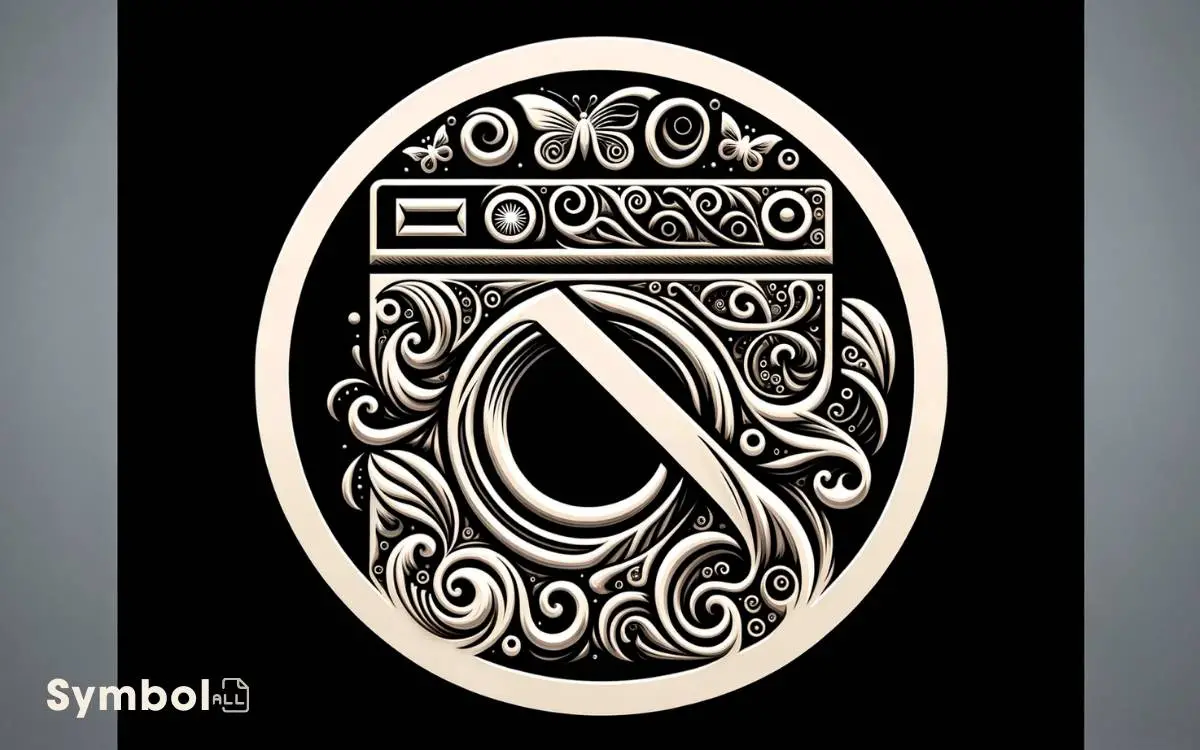Do Not Use Dryer Symbol: Mechanical Dryer!
The ‘Do Not Use Dryer’ symbol is critical for maintaining your clothes’ integrity. This emblem warns against tumble drying, protecting your garments from shrinkage, warping, and fading.
To adhere to this guideline, opt for air drying methods, which safeguard your wardrobe investments from the damaging high heat and mechanical action a dryer applies.
Understanding and respecting this symbol means selecting alternative drying practices like using a clothesline or drying rack, ensuring your clothes keep their shape, texture, and color.
If you pay attention to this and other care symbols, you’ll master the art of keeping your garments in pristine condition. These symbols serve as essential guides, ensuring that you treat each fabric with the care it requires. For example, certain materials, particularly those with delicate fibers or water-repellent coatings, often come with a caution to do not use fabric conditioner, as it can compromise their integrity. By adhering to these guidelines, you’ll not only extend the life of your clothing but also maintain their original quality and appearance.

Key Takeaways
Understanding Laundry Symbols
To effectively manage your laundry, it’s crucial to grasp the meanings behind the various symbols found on clothing care tags. These symbols provide vital instructions for washing, drying, ironing, and bleaching.
A bucket symbol, for instance, indicates washing guidelines numbers inside the bucket specify the maximum temperature in Celsius.
A triangle signifies bleaching instructions; if crossed out, it means don’t bleach. For ironing, look for an iron symbol; dots within indicate the temperature setting required.
Understanding these symbols guarantees you’re treating your garments correctly, preventing damage. Familiarize yourself with these icons, as they’re your clothes’ language for care. It’s a technical yet straightforward guide to keeping your wardrobe in pristine condition.
The Importance of the ‘Do Not Use Dryer’ Symbol
Recognizing the ‘Do Not Use Dryer‘ symbol is vital for maintaining your clothing’s integrity and appearance. By adhering to this directive, you’re employing best practices in garment care that prevent potential damage such as shrinkage, warping, or fading.
Understanding this symbol’s significance guarantees you’re informed about the risks of high heat and mechanical action on certain fabrics, safeguarding your wardrobe investments.
Symbol Meaning & Significance
Understanding the ‘Do Not Use Dryer‘ symbol is crucial for preserving the integrity of your garments by avoiding damage caused by inappropriate drying methods.
This symbol, typically a square with a circle inside crossed out by a line, signals that the fabric or the construction of the item won’t withstand the high heat or tumbling action of a dryer.
Ignoring this warning can lead to shrinkage, warping, or even complete disintegration of delicate materials.
It’s a direct message from the manufacturer, based on rigorous testing, to guide you towards alternative drying methods such as air drying or flat drying.
Recognizing and adhering to this symbol guarantees your clothes maintain their shape, texture, and color, safeguarding your investment in your wardrobe.
Clothing Care Best Practices
Adhering to the ‘Do Not Use Dryer’ symbol is paramount in employing the right care practices for your clothing, ensuring they remain in pristine condition over time.
Here’s a detailed guide to help you:
- Air Drying: Opt for air drying on a flat surface or hanger to maintain fabric integrity and prevent shrinkage.
- Fabric Care: Understand your garment’s fabric; delicate fabrics require more gentle care than sturdy cottons or synthetics.
- Temperature Control: Avoid exposing clothes to direct sunlight or high temperatures during air drying to prevent color fading and fabric weakening.
- Proper Storage: Once completely dry, fold or hang your clothes promptly. This prevents wrinkles and preserves the shape and quality of the garment, ensuring longevity and sustained appearance.
Potential Damage Risks
Ignoring the ‘Do Not Use Dryer’ symbol can expose your garments to several risks, including shrinkage, distortion, and fabric damage, that compromise their longevity and appearance.
High temperatures and tumbling actions in dryers can weaken fibers, causing them to break down more quickly than if air-dried. For delicate fabrics like silk and lace, the dryer’s intense environment can lead to irreversible damage such as tearing or fraying.
In addition, synthetic materials might melt or warp, altering the fit and ruining the garment’s structure. Even natural fibers aren’t immune; wool, for example, can felt and shrink, drastically changing its texture and size.
Understanding these risks underscores the importance of adhering to care labels, ensuring your clothes maintain their intended look and feel for longer.
Identifying the ‘Do Not Use Dryer’ Icon
To correctly identify the ‘Do Not Use Dryer’ icon, look for a square symbol with a circle inside it, often crossed out by a single line or an X, indicating that drying in a machine is prohibited for the item in question.
- Square Base: The icon starts with a square, which is the universal symbol for care instructions.
- Circle Inside: Within the square, a circle represents the dryer. Its presence alone without any cross signifies dryer usage is allowed.
- Crossing Line or X: A single line or an X through the circle explicitly forbids machine drying.
- Placement: This icon is found among other laundry symbols on your garment’s tag, often grouped with other drying or washing instructions.
Understanding this icon prevents potential damage to your clothes by ensuring you’re not using a dryer when it’s expressly prohibited.
Common Fabrics That Require Air Drying
After learning how to identify the ‘Do Not Use Dryer’ icon, it’s important you’re familiar with the types of fabrics that typically require air drying to maintain their integrity and appearance.
| Fabric Type | Care Instructions |
|---|---|
| Wool | Lay flat to avoid stretching. |
| Silk | Gently roll in a towel to remove excess water, then hang. |
| Lace | Lay flat on a clean, dry towel away from direct sunlight. |
| Linen | Smooth out wrinkles gently, hang or lay flat to dry. |
These materials demand careful handling to prevent shrinkage, shape distortion, or fiber damage. Wool sweaters, for instance, can stretch out of shape if hung while wet.
Silk and lace, delicate and prone to damage, thrive away from harsh machine tumbling. Linen, while robust, can become misshapen or overly wrinkled if not dried properly.
Risks of Ignoring the Dryer Warning
When you disregard the dryer warning on your garments, you’re risking significant fabric damage. This damage includes shrinkage, distortion, and color fading.
Ignoring this caution can also lead to an increased fire hazard due to the accumulation of lint and the potential overheating of fabrics not meant for high temperatures.
Furthermore, you compromise energy efficiency as these mishaps often require additional washing and drying cycles to rectify. This consumes more electricity and water.
Fabric Damage Risk
Ignoring the essential symbol on your clothing’s care tag can lead to irreversible fabric damage, including shrinkage, color fading, and breakdown of material integrity.
When you overlook this vital warning, you’re risking:
- Shrinkage: High temperatures can cause fibers to contract more than intended, altering the fit and appearance of your garment.
- Color Fading: Thermal exposure often leads to a loss of vibrancy, making your clothes look prematurely aged.
- Material Breakdown: Continuous drying can weaken fabric fibers, leading to tears and holes.
- Texture Alteration: Some fabrics may become stiff or lose their softness, impacting both comfort and aesthetic.
Understanding these risks helps you make informed decisions about garment care, preserving the life and look of your clothes.
Fire Hazard Increase
Beside the risk of damaging your clothes, ignoring the dryer symbol also significantly increases the chance of a fire hazard, posing serious safety concerns.
When you disregard these warnings, you’re often subjecting materials that aren’t designed to withstand high temperatures to intense heat. This can result in the ignition of flammable components, especially in items containing oils, rubber, or plastic.
It’s important to understand that lint accumulation, worsened by improper fabric types, can block your dryer’s ventilation. This blockage not only strains the dryer’s efficiency but also raises the temperature inside beyond safe levels, creating an ideal environment for a fire to start.
As a result, following the drying instructions isn’t just about garment care it’s an essential measure for preventing dangerous fires in your home.
Energy Efficiency Loss
Neglecting dryer symbols not only poses a fire hazard but also leads to significant energy efficiency loss in your appliance, as improper load types increase operational strain and power consumption.
Disregarding these warnings can result in:
- Extended Drying Times: Clothes not meant for the dryer may retain more water, necessitating longer cycles.
- Overworking the Motor: Non-compatible fabrics can cause the dryer to work harder, reducing its lifespan.
- Increased Power Usage: Longer cycles and harder work increase electricity consumption, escalating your bills.
- Wear and Tear on Components: The undue stress can lead to premature failure of critical parts, requiring costly repairs.
Comprehending and following dryer symbols not only guarantees safety but also preserves your dryer’s efficiency and longevity.
Alternative Drying Methods
If you’re looking for alternatives to machine drying, consider air-drying clothes on a clothesline or drying rack. This method reduces energy usage and extends fabric life by leveraging the natural heat from the sun and ambient air to evaporate moisture.
Not only does air-drying conserve electrical power, but it also minimizes the wear and tear on fabrics often caused by the tumbling action and high heat of dryers.
For best results, make sure garments are evenly spaced to promote airflow and speed up drying times. Additionally, positioning your clothesline or rack in a well-ventilated area, preferably with direct sunlight, enhances the drying efficiency.
Tips for Air Drying Clothes Effectively
Now that you’re familiar with the benefits of air-drying clothes, let’s explore some effective strategies to maximize the efficiency of this process.
- Choose the Right Location: Select an area with good airflow and, if possible, direct sunlight. This accelerates drying and helps prevent mildew.
- Maximize Space Between Garments: Guarantee clothes aren’t overlapping on the line or rack. Adequate space allows air to circulate freely, reducing drying times.
- Utilize Hangers for Certain Items: Delicates and shirts maintain their shape better when dried on hangers. Plus, this method can reduce wrinkling, minimizing ironing time.
- Flip Regularly: Turning your clothes midway through drying promotes even moisture evaporation, preventing damp spots and ensuring a thorough dry.
Caring for Delicate Garments
When handling delicate garments, it’s imperative to adopt a meticulous approach to avoid damaging their texture and integrity.
Here’s a concise guide:
| Step | Instructions |
|---|---|
| 1. Sorting | Separate by color and material. |
| 2. Cleaning | Use gentle detergents, hand wash if necessary. |
| 3. Drying | Lay flat on a clean towel, away from direct heat. |
| 4. Storing | Fold softly or hang using padded hangers. |
| 5. Repairing | Mend any tears or loose threads promptly. |
Maintaining Fabric Integrity Without a Dryer
To maintain the integrity of your fabrics without resorting to a dryer, it’s important to master alternative drying techniques that safeguard the material’s quality and longevity.
- Air-Dry Flat: Lay your garments on a clean, dry towel. Roll the towel with the garment inside to gently squeeze out excess water, then unroll and lay the item flat on a drying rack. This prevents stretching and maintains shape.
- Use Hangers: For items that won’t stretch, hang them on plastic or padded hangers. Avoid metal ones to prevent rust stains.
- Drying in Shade: Direct sunlight can fade colors. Dry your clothes in a shaded, well-ventilated area.
- Avoid Over-wringing: Twisting clothes to wring out excess water can damage fibers. Instead, gently press water out before drying.
Conclusion
In nurturing your wardrobe, heed the whisper of the ‘Do Not Use Dryer‘ symbol. It’s not merely a suggestion; it’s a guardian of your garments’ soul.
By embracing air drying, you’re not just preserving fabric integrity; you’re weaving respect into each fiber. Let patience be your guide and the air, your ally.
As clothes sway gently on the line, remember, you’re not only drying garments; you’re preserving a piece of the world, thread by thread. Treat them with care, and they’ll stand by you, season after season.






